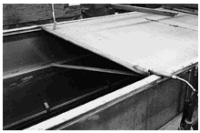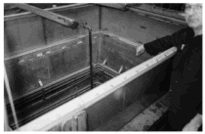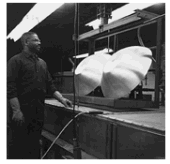Manufacturer Cuts Solvent Consumption
During the past eight years, this Connecticut manufacturer has cut solvent consumption 93 pct in degreasing applications...
Architectural Supplements (ASI),a Connecticut manufacturer of quality decorative metal products, has been able to reduce the solvent consumption in its vapor degreasing operation by nearly 93 pct over eight years while maintaining high-quality surface cleaning. The company has done this through upgrading degreasing equipment and introducing improved work practices.
During the same period, the firm converted its metal cleaning operation from 1,1,1-trichloroethane to trichloroethylene, with only minor adjustments in equipment. 1,1,1-trichloroethane was phased out of production for sales to emissive applications at the end of 1995.
ASI, a division of Intrex Corporation, Danbury, Connecticut, manufactures metal planters, planter walls, ashtray units, umbrella stands, outdoor planters and receptacles for the architectural and design market. These highly decorative products are widely used in hotel lobbies, casinos and other public buildings. Other divisions of Intrex make wood, plastic and fiberglass products.
Need to decrease emissions. "During the past decade," said Finishing Department Manager Jim Orrange, "we saw the need to decrease vapor emissions in the workplace and environment to meet increasing regulatory requirements. We also recognized our responsibility as corporate citizens to provide a clean environment for our community."
In the late 1970s, ASI began using 1,1,1-trichloroethane (TCA) to clean formed-metal units before painting and coating. Because appearance and uniform finish were important for these products, it was necessary to obtain a surface as free as possible of forming oils and metal fines.
TCA at the time was rapidly becoming the solvent of choice for such operations because of its high solvency and its relative safety. Since the solvent did not contribute to the formation of ground-level ozone, the chief component of smog, it was free from regulation as a volatile organic compound (VOC). The permissible exposure limit (PEL) set by the U.S. Occupational Safety and Health Administration (OSHA) was relatively high, 350 ppm on an eight-hour time-weighted average (TWA).
"By 1988 we were consuming 109,000 lbs of TCA annually," said Mr. Orrange. "But about that time we began to decrease solvent loss through more careful work practices."
Degreasing Aluminum Products. ASI's degreasing was carried out in a 48-sq-ft open-top Baron-Blakeslee degreaser equipped with both an ultrasonic immersion vat and a vapor degreasing section, as well as an in-line still for continuous recycling.
"Almost all of our products are aluminum," said Mr. Orrange. "So we had to keep a close watch on the solvent inhibitor system. Maintaining the inhibitor system prevents an aluminum reaction. We checked the solvent constantly for acid buildup and inhibitor level. We emptied the still weekly, and twice a year we replaced all the solvent.
"But in 1990 we added cartridge filters to the immersion vat," he said. "These filters cleaned the solvent in-line, taking some of the stress off our still. This enabled us to empty the still every other month, cutting down our solvent loss."
In 1993, faced with the impending phase-out of TCA, ASI decided to convert to another degreasing solvent. They tested several aqueous systems, but they found that the contours of many parts made it hard to completely dry the interior before applying paint. In addition, because of the size of many products, an extremely large cleaning tank and cleaning/drying line would be required.
The chlorinated solvents trichloroethylene (TCE) and methylene chloride (MEC) were also studied. Although there is no exact drop-in replacement for TCA, these related solvents come close. Both TCE and MEC provide similar degreasing power as TCA and can be used in the same degreasing and distillation equipment. Of the two, it was felt that TCE would be less costly to control because its higher boiling point and greater vapor density made the vapors easier to contain. It would be necessary, however, to upgrade the equipment to meet the lower threshold limit value (TLV) of TCE (50 ppm on an eight-hour TWA, and a 200 ppm short-term exposure limit or STEL1), and to meet the EPA's restrictions on TCE emissions to the atmosphere, since the solvent is classed as a VOC.
Upgrading degreaser equipment. The conversion took place in June and July 1993. The degreaser was emptied and cleaned out, and adjustments were made to accommodate the higher boiling point of TCE. After consultation with the solvent distributor, Hubbard-Hall Inc., Waterbury, Connecticut, a number of upgrades were added to the equipment, and changes in work practices were introduced. The following were the major changes introduced in the equipment:
- Freeboard height, which had been 75 pct of the degreaser width, was increased to 1.2 times the width.
- Refrigerated coils were installed above the original water cooling coils to confine the vapors more completely. The water coils are kept at 50 to 55F, but the refrigerated coils, manufactured by Ultra-Kool, Inc., operate at -20F. These are defrosted every half hour.
- An automated cover was added. This covers the degreaser partially or fully, both when work is held in the vapor zone or immersion vat, and when the degreaser is not in use.
Upgrading work practices. Among the improved work practices were the following:
- The holding rack was modified to better drain solvent from the work.
- The position of hollow products was changed to permit complete draining and allow all solvent to dry in the vapor area.
- Some parts had been degreased both before and after buffing, but this was found to be unnecessary. Now they are degreased only after buffing, decreasing the amount of work going into the degreaser.
- Chain speed was reduced to nine fpm, although 11 fpm is permitted.
- The vapor exhaust over the degreaser was eliminated, since the cold trap confined vapors to the vapor zone.
- ASI had been emptying and cleaning the degreaser every six months. With improved solvent maintenance, this was unnecessary. Today the degreaser is cleaned out only every two years.
Solvent loss reduced. These changes resulted in a drastic and continuing reduction in solvent loss. Annual solvent consumption in 1993 was already down to 22,173 lbs, consisting of 14,820 lbs of TCA and 7,353 lbs of TCE. In 1994, this was reduced by 35 pct to 14,352 lbs, and further to 9,882 lbs in 1995 and 7,959 lbs in 1996. This was just seven pct of the quantity of solvent consumed only eight years before.
"Since we used less than 10,000 lbs of solvent in 1995," said Mr. Orrange, "we could stop reporting our solvent consumption to EPA. That was a welcome reduction of paper work. And the reduction in solvent purchases paid off the cost of the machine upgrade in less than 15 months."
As ASI experienced this remarkable decrease in solvent consumption, the work going through the degreaser increased. Although production had leveled off for several years, it was up by 10 pct in 1995, and another 10 pct in 1996. Yet solvent consumption decreased by 31 and 19 pct , respectively, in those two years.
Anticipating an increase in product throughput, ASI installed a second 16-sq-ft vapor degreaser. Because of the efficiency of the operation in the larger degreaser, however, it has been unnecessary to bring this second degreaser into operation, even with the increase in production. At present, all degreasing is handled by one operator working a single eight-hour shift.
Maintaining solvent purity. Solvent maintenance is important because most parts cleaned in the degreaser are aluminum, which can react with chlorinated solvents. The presence of aluminum requires careful maintenance of the inhibitors that prevent solvent degradation; at the same time, continuous distillation may contribute to a gradual depletion of the inhibitors.
The trichloroethylene used by ASI is NEU-TRI2 solvent from The Dow Chemical Company, a grade of TCE specially inhibited for vapor degreasing. Hubbard-Hall, which is a Dow distributor in New England, assists ASI in the solvent maintenance program to assure that proper stabilizer levels are maintained. Each month a Hubbard-Hall technician visits ASI to test the solvent for acid acceptance and pH level, warning signs of solvent degradation. The technician also takes a sample of solvent back to the distributor's laboratory where it is tested via gas chromatography for stabilizer level. If the level is low, new additives (pH adjusters or stabilizers) are blended in to maintain the solvent stability.
Low workplace exposure. The current workplace TLV for trichloroethylene is 50 ppm on an eight-hour time-weighted average. ASI has been able to maintain a level well below this. The workplace vapor level is checked in several ways. Hubbard-Hall supplies ASI with dosimeter badges to test operator exposure periodically. In addition, a technician from the distributor checks all fittings in the equipment twice a year with a halogen leak detector. This is necessary because visual inspection is insufficient: leaking solvent vaporizes rapidly, while the human sense of smell is not keen enough to detect small leaks.
Each year a Hubbard-Hall technician also provides training for all personnel involved with the degreasing operation. This includes a survey of proper degreasing methods, safe handling of solvent, hazardous waste disposal, proper action in case of an incident, standard practice for confined area entry and first aid in case of exposure.
Safety and product stewardship literature are also provided, much of it produced by Dow for use with chlorinated solvents. Dow's easy-to-follow safety instruction poster, "Work with Safety First in Mind," hangs on the wall behind the degreaser, as do Material Safety Data Sheets from both Dow and Hubbard-Hall. Dow's Product Stewardship Manual for Chlorinated Solvents and its brochure on waste minimization methods are kept on hand. Operating personnel are furnished with a detailed booklet "How to Get Along with your Solvent."
At a time when many companies are opting away from the chlorinated solvents, Architectural Supplements has proven that TCE can be used safely, in compliance with all regulations and without putting a strain on the environment. And at the same time, the company has obtained outstanding degreasing of quality products while experiencing a major reduction in both solvent loss and solvent consumption.
1. As set by the American Conference of Governmental Industrial Hygienists (ACGIH)
Read Next
Episode 45: An Interview with Chandler Mancuso, MacDermid Envio Solutions
Chandler Mancuso, technical director with MacDermid Envio discusses updating your wastewater treatment system and implementing materials recycling solutions to increase efficiencies, control costs and reduce environmental impact.
Read MoreEducation Bringing Cleaning to Machining
Debuting new speakers and cleaning technology content during this half-day workshop co-located with IMTS 2024.
Read MoreDelivering Increased Benefits to Greenhouse Films
Baystar's Borstar technology is helping customers deliver better, more reliable production methods to greenhouse agriculture.
Read More






















.jpg;maxWidth=300;quality=90)






